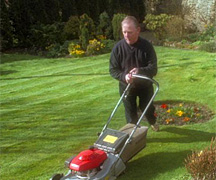Safety in the Garden
Taking Precautions
Whilst gardening is, for the most part, a healthy and pleasurable pastime, it is important to appreciate that there are also risks that can affect your health and safety.
Most gardening requires the use of sharp tools, possibly electricity or other power sources, sometimes working at height, use of potentially dangerous chemicals and even some risks that are inherent to nature itself.
It pays, therefore to plan ahead about your gardening activities and then ensure you are equipped to properly manage the risks.
If you have children in your garden, then you also need to view our page on Child Safety in the Garden.
Here are some high-level precautions that are worth taking. Some may need to be adapted to your specific circumstances, but you will get the idea. You will inevitably come across other situations for which you need to work out your own safety precautions.
There are well-established procedures for managing health and safety risks in just about every industry. If you are not familiar with these procedures a few minutes learning about them is time well spent and then you can apply the principles to all your gardening activities.
Read Also:
Safety as Top Priority

Gardening tools and equipment, whether powered or not, can cause serious injury. It is wise, therefore, to ensure you are clear on the correct way to use each item and that you examine equipment for potentially dangerous faults before you use it.
- As far as practical, avoid distractions and ensure young children and pets are kept under proper control when they are around gardening equipment.
- Read instructions and warning labels on garden equipment.
- Avoid working with blunt tools such as saws or axes since the additional effort required can introduce its own risks. Know how to sharpen your tools or take them to a professional for sharpening
- Ensure your tetanus injection is up to date. Tetanus lives in soil and because gardeners are constantly working with soil as well as with tools that can cut or puncture the skin, they are particularly susceptible to tetanus infection.
- Take care when handling chemicals of any kind but especially so when they are known to be poisonous. Always keep them in their correct containers, ensure they are clearly labelled and store them out of harms way. If you are using other equipment for chemicals, as when spraying, ensure it is properly cleaned after use and before putting away.
Safe Lifting
Gardening activities often involve lifting and moving heavy objects so, to minimise the risk of injury, you should understand and practice the principles of safe manual handling.
You can find comprehensive instruction in the HSE booklet "Getting to Grips with Manual Handling".
In very simple terms, safe manual handling involves:
- Keeping your back straight
- Using your strong leg muscles to do the lifting
- Avoiding overstretching yourself
- Avoiding twisting motion
- Only attempting to lift weights within your natural handling capacity
- Making maximum use of mechanical lifting and moving equipment
However, you would be well advised to study the much more comprehensive instructions in the free booklet.
Wear Appropriate Clothing
The best way to manage health and safety is to eliminate any risks by finding safer methods or even avoiding the need for the activity in the first place. However, there are some risks that we cannot avoid and therefore, we should be suitably dressed to safeguard ourselves.

- Strong waterproof shoes or boots are very important. Trying to garden in flimsy footwear is simply inviting serious accidents. Similarly, most of the time you need to protect your hands with a sturdy pair of gardening gloves.
- Wear gloves when handling chemicals and if you are spraying, then wear a face mask and protection for your eyes.
- If you are using machinery such as a lawn mower, you also need to wear clothing that will protect you against missiles such as stones that are picked up and thrown out by the mower.
- Much gardening is done on your knees and therefore you should protect them, either with strap on kneepads or with some form of substantial kneeling cushion.
- Some items of garden equipment, such as chain saws, are notoriously dangerous, particularly in the hands of the inexperienced gardener. You would be well advised to seek our proper instruction on how to use such equipment safely. In addition, you need addition protection for hands, arms, legs and eyes.
- In some cases you may also need to protect your hearing from prolonged use of particularly noisy equipment. Use, either earmuffs or other form of protection that is designed for the purpose.
- The sun can also pose a threat to health and safety. Use sun screen, sunglasses and preferably wear clothing and a hat to protect you from the direct rays of the sun.
- It is generally good practice to tuck trouser bottoms into your socks to guard against the possibility of being bitten by mosquitoes or ticks.
Legionella
It is not widely appreciated that it is possible to contract a form of Legionella from handling compost (Legionella longbeachae)
Whilst rare in the UK, there have been a small number of cases of Legionella that have been linked to contact with compost. The problem is more common in Australia and New Zealand where bags of compost purchased from garden centres carry warning signs
Symptoms are similar to those from the more common form of Legionella contracted by breathing in water droplets from cooling towers, i.e. headache, diarrhoea and dry cough, followed by pneumonia.
This is not considered to be a major risk, but gardeners are nonetheless encouraged to wash their hands after working with compost and certainly before eating.
